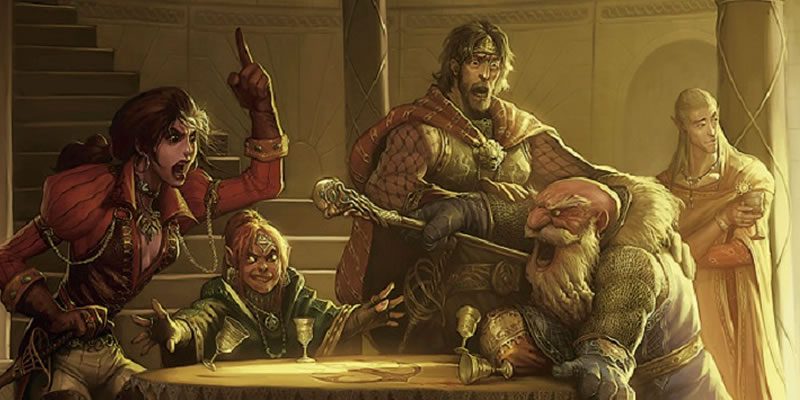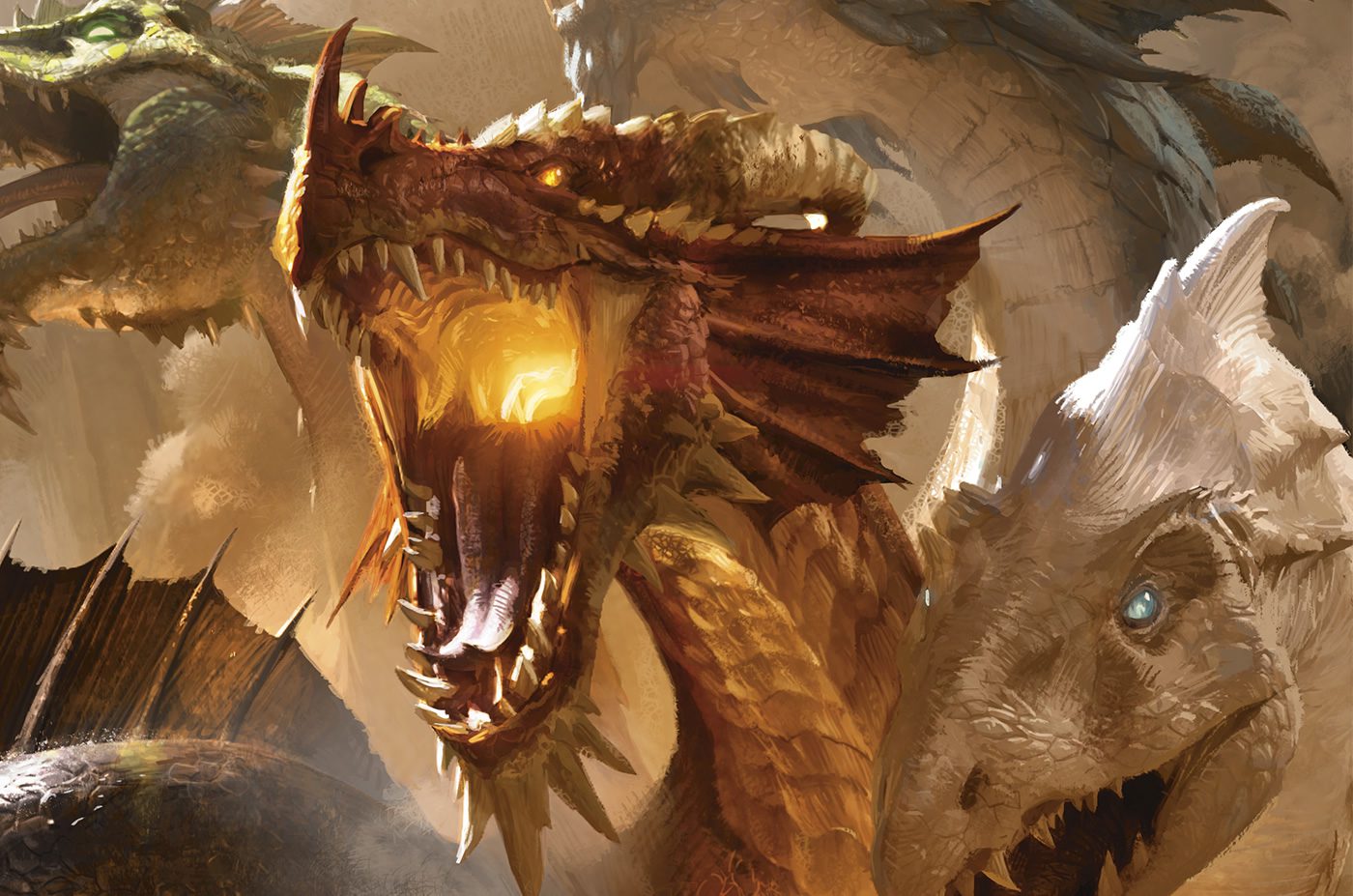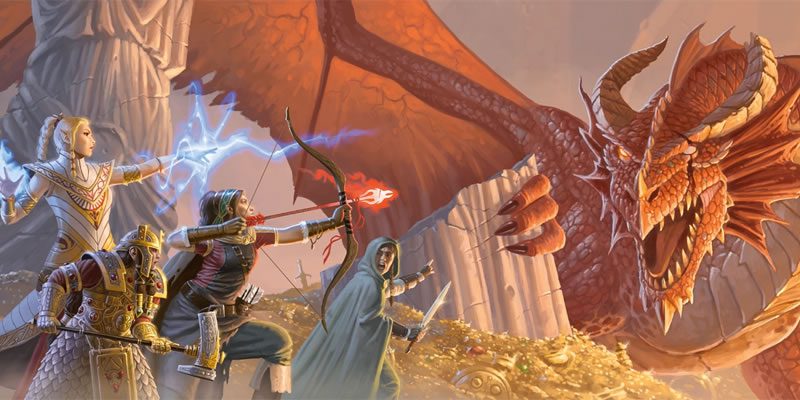D&D 5e Combat – Initiative House Rule Option #1

I wrote an article about initiative, strategy and team play. Recently after reading some more, and playing, I am ready to just throw Initiative out the window. I am more in favor of what Robert Schwalb has going with in his new game “Shadow of the Demon Lord.” He uses an Action Economy system and a simplified system that let’s the players go in what ever order they want. I really like that system, but want to use it for D&D 5th edition. So let’s first look at how initiative works in D&D. The players all roll a d20 and perform a Dexterity Check to determine initiative order like this example:
Dexterity Check results:
- 18 – Player 1/Player 2 tied
- 17 – MONSTERS
- 15 – Player 3
- 12 – Player 4
- -1 – Player 5
Then the players can discuss who will go first, Player 1 or Player 2. And if you have any doubts that this is not rules as written (RAW). then just look to page 189 in the Player’s Handbook or Page 69 in the Basic D&D rules. The “players decide the order among their tied characters.” There is always the DM clause, and the DM can ask for a roll-off between players, but why take this away from players unless they just can’t decide.
Initiative Order:
- Player 2
- Player 1
- MONSTERS
- Player 3
- Player 4
- Player 5
After this Initiative order is determined, then it is set and doesn’t change. A player can take a delay action, but that just turns their action into a Reaction. Which they can only have one of those, and would potentially lose any other reactions that may happen.
Combat Step by Step
Here is what I want to change:
1.Determine surprise. The DM determines whether anyone involved in the combat encounter is surprised.
2.Establish positions. The DM decides where all the characters and monsters are located. Given the adventurers’ marching order or their stated positions in the room or other location, the DM figures out where the adversaries are—how far away and in what direction.
3.Roll initiative. Everyone involved in the combat encounter rolls initiative, determining the order of combatants’ turns.
4.Take turns. Each participant in the battle takes a turn in initiative order.
5.Begin the next round. When everyone involved in the combat has had a turn, the round ends. Repeat step 4 until the fighting stops.
House Rule
So how can I house rule and take out the initiative rolls, and give the players some more ability to strategize and create more teamwork?
Robert has details with his RPG system with an action economy system complex, simple and extra actions, but I’m more interested in how to make combat work in D&D 5e without initiative. http://schwalbentertainment.blogspot.com/2014/11/demon-lord-who-goes-when.html So there is the Fast Round, Slow Round and End of Round. Player’s go first in any order they like. In Shadow of the Demon Lord, players that take the slow turn would gain an additional action.
So taking that into D&D 5th edition, if they choose to take the Fast Round then they can take their normal actions (move,action,potential bonus action), if they choose the Slow Round then they take their normal actions, but should be awarded something based on taking their time and letting other players & monsters go first.
If they take the slow round they take the risk of being attacked by the monsters first. I could have gone with a Bonus Action, Additional Action like Robert, or a damage bonus like a critical hit. I instead decided to use the one D&D 5th edition flavored device, and that gives the player Advantage on one attack roll. This will keep the math flat and easy, but increases the chances of a Critical Hit and potential damage. It could also cancel out disadvantage that they may have for some reason.
1.Determine surprise. The DM determines whether anyone involved in the combat encounter is surprised.
2.Establish positions. The DM decides where all the characters and monsters are located. Given the adventurers’ marching order or their stated positions in the room or other location, the DM figures out where the adversaries are—how far away and in what direction.
3.Roll initiative. Everyone involved in the combat encounter rolls initiative, determining the order of combatants’ turns.
4.Take turns. Each participant in the battle takes a turn in initiative order.
4a. Fast Turn: Each player decides if they want to take a Fast Turn. Players always go first before monsters. The DM decides if any monsters take actions during the Fast Turn.
4b. Slow Turn: Each player or monster that didn’t take a Fast Turn can now take the Slow turn. They will receive advantage on a skill check, saving throw or to hit check if they are conscious. Monsters go after Players.
4c. End of Round: Any saving throws or effects that normally end at the end of the turn would end here after a saving throw is made successfully. Death Saving throws take place here.
5.Begin the next round. When everyone involved in the combat has had a turn, the round ends. Repeat step 4 until the fighting stops.
Seems pretty simple, so here’s an example of play. The only thing that has changed is that the players collectively determine their “turn order,” and on a player’s turn, they would move a distance up to your speed and take one action
Goblin Ambush
There are four goblins hiding along the road ahead. Two on each side of the road in the woods. The players have stopped their wagon to investigate two dead horses that block the trail. As they approach the horses they see the saddlebags of the horses have been looted and an empty leather map case lays to the side of the road in grass. There are 5 players; two fighters, a wizard, cleric and rogue.
<Round 1 >
Determine Surprise as normal. Players go first before monsters if they aren’t surprised.
The players each have a passive perception of Human Fighter-Noble 13, Dwarf Cleric-Soldier 13, Halfling Rogue-Criminal 10, Elf Wizard-Acolyte 13, Human Fighter-Folk Hero 13. So the goblins are hiding they gain a +6 on their Stealth Skill and we roll once for all of them for their Dexterity(Stealth) check to see if any of the party is surprised. I roll an 11 so they have a Stealth check of 17, which surpasses all of the party’s passive perception, and the goblin’s gain surprise. Two goblins will make melee attacks, while the other two goblins will stand 30 feet way and make ranged attacks.
<Fast Turn>
Each player decides if they want to take a Fast Turn. Players go first before monsters. The DM decides if any monsters take actions during the Fast Turn.
Players: None of the players would act during this Surprise Round. They are all surprised.
Monsters: The two goblins in the woods attack with their short bows (+4 to hit) and have advantage on their attacks rolls and attack the cleric and rogue. The first rolls a 10|1, and a the other a 15|8. With a +4 that makes it a 14 and 19 respectively and hit. The 14 misses the cleric, but the 19 will hit the halfling for 5 piercing damage. The two goblins in the wooded area will attempt a hide action as their bonus action and roll a collective 10 on their Stealth check with a +6 for a total of 16.
Human Fighter-Noble AC 17, HP 12
Human Fighter-Folk Hero AC 14, HP 12
Dwarf Cleric-Soldier AC 18, HP 11
Halfling Rogue-Criminal AC 14, HP 9 4
Elf Wizard-Acolyte AC 12, HP 8
Goblin 1 AC 14, HP 7
Goblin 2 AC 14, HP 7
Goblin 3 AC 14, HP 7
Goblin 4 AC 14, HP 7
<Slow Turn>
Each player or monster that didn’t take a Fast Turn can now take the Slow turn. They will receive advantage on a skill check, saving throw or to hit check if they are conscious. Monsters go after Players.
Players: None of the players would act during this Surprise Round. They are all surprised.
Monsters: Two goblins take the slow turn and use advantage with their attack. They rush forward and attack the two fighters separately with scimitars (+4 to hit) and roll a 14|8 and a 12|3 for an 18 to hit against the first fighter, and a 16 to hit the second fighter. The first fighter has an AC of 17 and is hit, the other fighter has an AC of 14 and is also hit. Each fighter takes 5 HP of slashing damage.
Human Fighter-Noble AC 17, HP 12 7
Human Fighter-Folk Hero AC 14, HP 12 7
Dwarf Cleric-Soldier AC 18, HP 11
Halfling Rogue-Criminal AC 14, HP 9 4
Elf Wizard-Acolyte AC 12, HP 8
Goblin 1 AC 14, HP 7
Goblin 2 AC 14, HP 7
Goblin 3 AC 14, HP 7
Goblin 4 AC 14, HP 7
<End of Round 1>
Any saving throws or effects that normally end at the end of the turn would end here after a saving throw is made successfully. Death Saving throws take place here.
< Round 2>
<Fast Turn>
Each player decides if they want to take a Fast Turn. Players go first before monsters. The DM decides if any monsters take actions during the Fast Turn.
Players: So the two fighters will attack the goblins. Rolling a 15 and 19 for each fighter with +5 to hit (20 & 24) they easily hit the Goblins with an AC of 14. The fighter’s great axe does a 1d12+3 slashing damage and he rolls a 12 for 15 damage that kills the goblin. The other fighter uses his greatsword for 2d6+2 slashing damage for rolling 4&2 for 8 points of damage that also takes the goblin to 0 hit points.
Monsters: The two remaining goblins are hidden and gain advantage on attacks, and then fire their arrows at the fighters and the first rolls a 7|5, and a the other a 19|3. The first misses, but the second goblin’s arrow hits the fighter for 5 piercing damage. The two goblins will attempt a hide action as their bonus action and roll a collective 7 on their Stealth check with a +6 for a total of 13. The player’s can contest the Stealth check total on their turn to see if they can see the goblins.
Human Fighter-Noble AC 17, HP 12 7
Human Fighter-Folk Hero AC 14, HP 12 7 2
Dwarf Cleric-Soldier AC 18, HP 11
Halfling Rogue-Criminal AC 14, HP 9 4
Elf Wizard-Acolyte AC 12, HP 8
Goblin 1 AC 14, HP 7 0
Goblin 2 AC 14, HP 7 0
Goblin 3 AC 14, HP 7
Goblin 4 AC 14, HP 7
<Slow Turn>
Each player or monster that didn’t take a Fast Turn can now take the Slow turn. They will receive advantage on a skill check, saving throw or to hit check if they are conscious. Monsters go after Players.
Players: The wizard, cleric and rogue can now take their actions and movement. The player’s decide to let the cleric go first to perform healing, then the wizard and the rogue last.
The cleric performs some healing on the Fighter that is at 2 hit points. The cleric uses one of his two spell slots and casts cure wounds for 1d8+5 and rolls a 6 for 11 hit points of healing bringing the fighter to full hit points.
The wizard rolls 12|4 for a Search action to find the goblins. The higher roll of 12 gives him a total of 15 perception. He sees the goblin that is hiding, and points them out to the party.
The rogue sees the goblins 30 feet away with the wizard pointing at them, and shoots his shortbow at one of the goblins. He has advantage from taking the slow turn, and rolls a 18|10 for his short bow attack and hits the goblin. The goblin will take 1d6+3 piercing damage and 1d6 sneak attack damage. The rogue player rolls a 4 & 3 for a total of 10(4+3+3) piercing damage killing the goblin.
Monsters: All monsters took their action during the Fast Turn.
Human Fighter-Noble AC 17, HP 12 7
Human Fighter-Folk Hero AC 14, HP 12 7 2 12
Dwarf Cleric-Soldier AC 18, HP 11
Halfling Rogue-Criminal AC 14, HP 9 4
Elf Wizard-Acolyte AC 12, HP 8
Goblin 1 AC 14, HP 7 0
Goblin 2 AC 14, HP 7 0
Goblin 3 AC 14, HP 7 0
Goblin 4 AC 14, HP 7
<End of Round 2>
Any saving throws or effects that normally end at the end of the turn would end here after a saving throw is made successfully. Death Saving throws take place here.
The start of Round 2 would begin again with a Fast Turn, Slow Turn and End of Round. The combat could conclude with the last goblin trying the flee during the fast turn, if the players all take a slow turn. The players could end up chasing after him to see where he lives and find some treasure.
Conclusion
I believe this can take away from the drudgery of the initiative order tracking, and keep the player’s more engaged during the combat. The DM will just ask, who wants to take the Fast Turn, players will take their actions. Then the DM decides on Monsters taking a Fast turn, then its the remainder of the players to take the slow turn. and then the remainder of the monsters. It might work really nice. Really!
It also helps with the flow of the game and lets the players work as a team and strategize some more instead of a set initiative order. Some problems that may arise that I have seen in the past is that a player gets skipped. A lot of DM’s have trouble even following initiative order tracking and easily skip a player’s turn. With the players more in control then it is a little harder for this to happen. This should take away from any other mechanic in the game like attacks of opportunity.
If you like the house rule, let me know how it works out for you. If there are any tweaks that can be made or you see a loop hole, I’d love to hear about them and strengthen the house rule.
More Thoughts [EDIT: 12/23/2014]
I have been playing with the house rule a few sessions, and the players like the Fast Turn. They just want to rush in and kill everything first, and they don’t want to wait. Exact opposite of what I was expecting.
I’ve also had some great comments from a lot of great minds, and someone has suggested instead of granting advantage on the Slow Turn, instead grant some other action, or take away an action during the Fast Turn. Granting another action seems very strong. There are several actions that players normally don’t focus on during combat because they want to use their Attack action, and a lot of times they will stay in one spot during combat so I think going forward taking away movement wouldn’t hurt the players. And this fits more inline with what Robert Schwalb has created for his game. He is a genius afterall. 😉
1.Determine surprise. The DM determines whether anyone involved in the combat encounter is surprised.
2.Establish positions. The DM decides where all the characters and monsters are located. Given the adventurers’ marching order or their stated positions in the room or other location, the DM figures out where the adversaries are—how far away and in what direction.
3.Roll initiative. Everyone involved in the combat encounter rolls initiative, determining the order of combatants’ turns.
4.Take turns. Each participant in the battle takes a turn in initiative order.
4a. Fast Turn: Each player decides if they want to take a Fast Turn. Players always go first before monsters. The DM decides if any monsters take actions during the Fast Turn. They can take an Action and a possible Bonus Action. (No movement unless a Dash Action is used)
4b. Slow Turn: Each player or monster that didn’t take a Fast Turn can now take the Slow turn. Monsters go after Players. They can take an Action, Movement, and a possible Bonus Action.
4c. End of Round: Any saving throws or effects that normally end at the end of the turn would end here after a saving throw is made successfully. Death Saving throws take place here if the players went to 0 HP last round.
5.Begin the next round. When everyone involved in the combat has had a turn, the round ends. Repeat step 4 until the fighting stops.
I’ll playtest some more, and see how it goes.
-Michael
twitter: @mrlong78
https://www.facebook.com/groups/DnD5th/
https://www.facebook.com/schwalbentertainment
http://schwalbentertainment.blogspot.com



